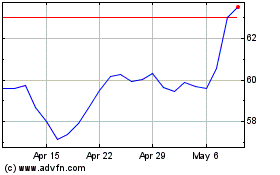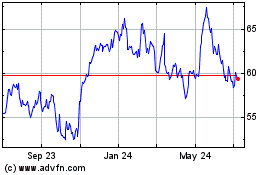By Mark Maurer and Nina Trentmann
Finance chiefs are tackling one of the biggest business
challenges during the coronavirus pandemic: maintaining
liquidity.
The lockdown of significant parts of the world economy is
resulting in revenue declines for hotel operators, airlines,
retailers, car manufacturers and many other companies. Businesses
also are navigating supply-chain disruption and a surge in costs
related to the transition to remote work.
Companies are cutting expenses -- not for profit, but to
preserve cash -- idling plants and furloughing or laying off
employees to ensure they survive. And CFOs are leading the charge
in extending credit lines, bolstering emergency cash reserves and
tapping bond markets, as they revise debt strategies and seek to
avoid mistakes from past crises.
"As we look forward without knowing exactly where this is headed
-- the depth and the length of the strain on the economy --
liquidity is the number one question that rises to the top of the
list in terms of viability of a business," said Mike Zechmeister,
finance chief of freight broker C.H. Robinson Worldwide Inc.
The Federal Reserve in recent weeks unveiled various measures
aimed at alleviating credit stress and providing companies with
access to capital, including purchases of commercial paper, a $4
trillion backstop for money-market funds, corporate-bond purchases
and direct bridge loans to businesses.
On Thursday, the Fed said it would expand lending programs to
companies with weaker credit ratings, including those that had
their creditworthiness downgraded since the outbreak of the
coronavirus in the U.S. The central bank said it would offer loans
for small businesses -- the Main Street Landing Program -- which
comes on top of forgivable loans for payroll costs from the Small
Business Association.
Meanwhile, companies are looking to expand their capital
buffers. Mr. Zechmeister, for instance, has tested borrowing off
the company's existing $1 billion credit facility to make sure
additional liquidity would be ready for use as needed. The company,
which held $448 million in cash and cash equivalents at the end of
December, also is examining accounts receivable and overdue
payments to manage its liquidity position, Mr. Zechmeister
said.
Covestro AG, a German specialty-plastics maker, drew down on
existing EUR500 million ($547 million) working capital facilities
and secured a EUR225 million loan as it looks to accelerate
existing cost-cutting plans and reduces capital expenditures, CFO
Thomas Toepfer said.
Other companies, such as Ford Motor Co. and Children's Place
Inc., have suspended dividends, while AT&T Inc., JPMorgan Chase
& Co. and others have halted share-repurchase plans.
Rush for New Debt
Some businesses have turned to the bond market to extend
maturities and strengthen their liquidity buffer. Fortune 500
companies have about $981 billion in maturities between now and the
end of next year, according to data from Dealogic Inc.
Anheuser-Busch InBev SA said last week one of its subsidiaries
issued $6 billion in new bonds. The brewer plans to hold the
proceeds as cash while conditions remain uncertain, and use them to
reduce debt as market conditions normalize. "At any given time, we
work to have enough cash on hand to meet our liquidity needs for
more than one year, especially in times of increased volatility,"
said Lauren Abbott, vice president of investor relations at the
Belgium-based company.
Howard Hughes Corp., a Dallas-based real-estate developer,
raised $600 million late last month through an equity issue and a
parallel private placement. Together with existing cash, Howard
Hughes now has about $1 billion at hand. "This will help us survive
this, independent of how deep or how long this pandemic will be,"
Chief Financial Officer David O'Reilly said.
Some CFOs are attempting to avoid struggles faced during the
financial crisis. Sonic Automotive Inc., a Charlotte, N.C.-based
car-dealership chain, defaulted on bonds in 2009. In recent weeks,
the company has drawn down credit lines and communicated with
banking partners to ensure assistance in securing other lines if
needed, Sonic CFO Heath Byrd said.
"We all know the banks are in very good shape, which is such a
blessing in hindsight that 2009 happened and created those
liquidity ratios to be better for the banks," he said.
Some lenders are shrinking lines of credit they have with their
customers to minimize the risk of company defaults and
bankruptcies. In recent weeks, that credit crunch has pushed some
companies closer to breaching debt covenants. Coal supplier Murray
Energy Corp. said it is concerned it may breach covenants in its
bankruptcy loan after its finances were hit hard by the pandemic
and beleaguered coal markets.
Starting Short
Access to public debt markets and new bank loans is limited for
many companies, depending on the health of the business and their
credit rating. Companies whose debt was barely investment grade at
the start of the pandemic likely will struggle to meet their debt
obligations, said Nilly Essaides, a senior research director at
Hackett Group Inc.
Rating firms have downgraded a flurry of companies in recent
weeks, which can reduce their access to the public markets or
result in higher cost of debt.
Companies need to examine their debt covenants and keep the
communication open with rating firms and debtors before defaulting,
Ms. Essaides said.
The pandemic also has prompted CFOs to consider debt issuances
as far as four years into the future. Companies that might be
planning to issue debt in 2021 or 2022 can lock in financing at the
current interest rates with a hedge. "If rates go lower, you might
regret that you entered the hedge," said Amol Dhargalkar, managing
director at financial-risk adviser Chatham Financial Corp.
As an alternative, companies may rely on cash pooling, the
internal shifting of money from cash-rich entities to those that
are cash-starved, Ms. Essaides said.
Write to Mark Maurer at mark.maurer@wsj.com and Nina Trentmann
at Nina.Trentmann@wsj.com
(END) Dow Jones Newswires
April 10, 2020 05:44 ET (09:44 GMT)
Copyright (c) 2020 Dow Jones & Company, Inc.
Anheuser Busch Inbev SA NV (NYSE:BUD)
Historical Stock Chart
From Mar 2024 to Apr 2024

Anheuser Busch Inbev SA NV (NYSE:BUD)
Historical Stock Chart
From Apr 2023 to Apr 2024
